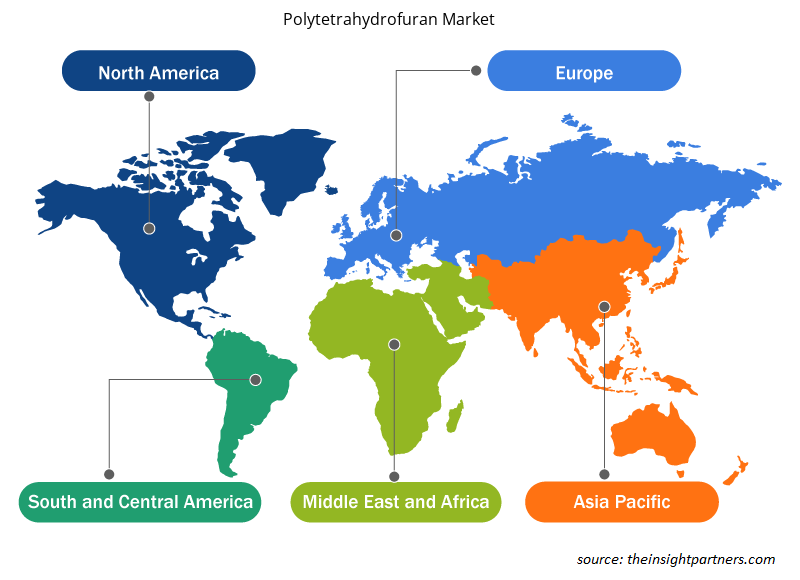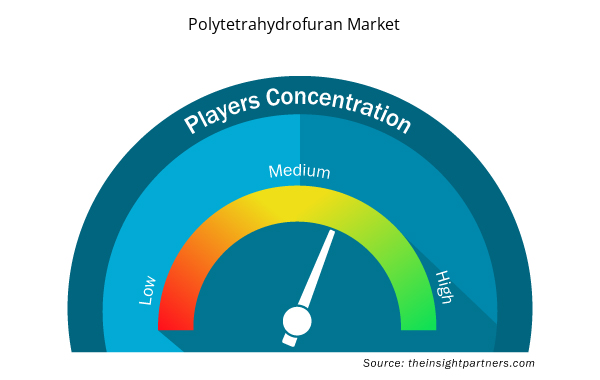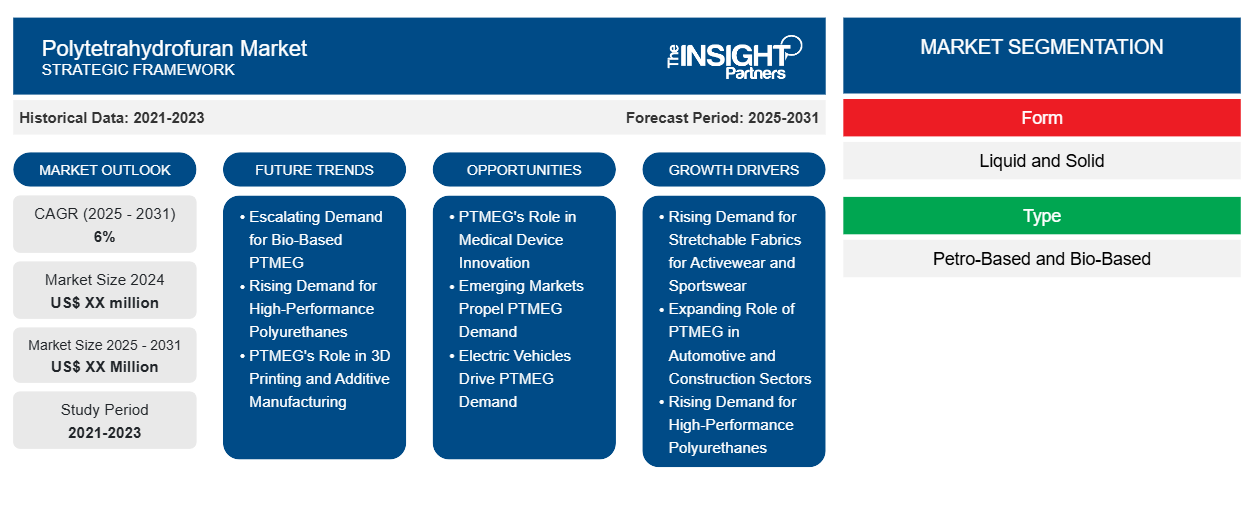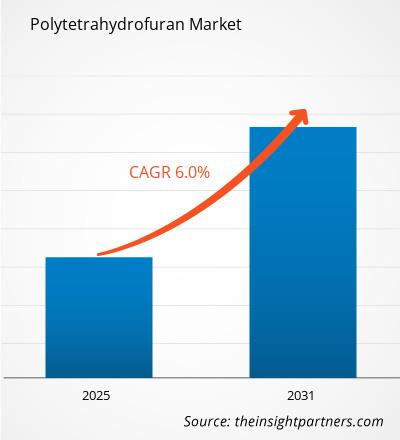Si prevede che il mercato del politetraidrofurano registrerà un CAGR del 6% dal 2024 al 2031, con una dimensione di mercato in espansione da XX milioni di dollari USA nel 2024 a XX milioni di dollari USA entro il 2031.
Il rapporto di mercato del politetraidrofurano è segmentato per forma (liquido e solido). Il mercato è segmentato in base al tipo (petrolifero e bio-based). Il mercato è segmentato in base all'applicazione (poliuretano termoplastico, fibre di spandex, elastomero copoliestere-etere e altri). Il mercato è segmentato in base all'uso finale (vernici e rivestimenti, tessuti, adesivi e sigillanti, pelle artificiale e altri). Le dimensioni e le previsioni del mercato a livello globale, regionale e nazionale per tutti i segmenti di mercato chiave sono coperte nell'ambito. Il rapporto offre il valore in USD per l'analisi, i segmenti, le regioni e i paesi di cui sopra. Il rapporto copre le tendenze di mercato, nonché le dinamiche di mercato come driver, vincoli e opportunità chiave. Il rapporto copre anche il panorama del settore e l'analisi della concorrenza che copre la concentrazione del mercato, l'analisi della mappa di calore, i principali attori e gli sviluppi recenti nel mercato.
Scopo del rapporto
Il report Polytetrahydrofuran Market di The Insight Partners mira a descrivere il panorama attuale e la crescita futura, i principali fattori trainanti, le sfide e le opportunità. Ciò fornirà spunti a vari stakeholder aziendali, come:
- Fornitori/produttori di tecnologia: per comprendere le dinamiche di mercato in evoluzione e conoscere le potenziali opportunità di crescita, consentendo loro di prendere decisioni strategiche informate.
- Investitori: condurre un'analisi completa delle tendenze in merito al tasso di crescita del mercato, alle proiezioni finanziarie del mercato e alle opportunità esistenti lungo la catena del valore.
- Enti di regolamentazione: regolamentano le politiche e le attività di controllo sul mercato allo scopo di ridurre al minimo gli abusi, preservare la fiducia degli investitori e sostenere l'integrità e la stabilità del mercato.
Segmentazione del mercato del politetraidrofurano
Modulo
- Liquido e solido
Tipo
- Basato su petrolio e basato su bio
Applicazione
- Poliuretano termoplastico
- Fibre di spandex
- Elastomero copoliestere-etere
Geografia
- America del Nord
- Europa
- Asia-Pacifico
- America del Sud e Centro
- Medio Oriente e Africa
Personalizza questo report in base alle tue esigenze
Riceverai la personalizzazione gratuita di qualsiasi report, comprese parti di questo report, o analisi a livello nazionale, pacchetto dati Excel, oltre a usufruire di grandi offerte e sconti per start-up e università
- Scopri le principali tendenze di mercato in questo rapporto.Questo campione GRATUITO includerà analisi di dati che spaziano dalle tendenze di mercato alle stime e alle previsioni.
Fattori trainanti della crescita del mercato del politetraidrofurano
- Rising Demand for Stretchable Fabrics for Activewear and Sportswear: Polytetrahydrofuran, commonly known as PTMEG, is a key raw material for the production of polyurethane elastomers that mostly include spandex fibers. It is convertible fibers into a man-made textile that is primarily used in the manufacturing of highly stretchable skin-tight garments, such as those worn in activewear, sportswear, or in fashionable styles. Applications tend to focus on the increased demand for stretchy, comfortable, high-performance fabrics in the clothing industry - hence PTMEG is consumed. Thus, advancement in such stretchable as well as durable materials qualities for both fitness and performance has been fuelling growth in that section of PTMEG as a basic ingredient which forms an integral-critical part.
- Expanding Role of PTMEG in Automotive and Construction Sectors: Thus, this development in PTMEG has paralleled the surge in the automotive and construction sectors. In automotive production, polyurethanes are employed for seating, thermal insulation, and also cushioning. Similarly, this polymer is used in coatings and sealants as well as insulation products in the construction industry. The bulk of PTMEG used is a primary resource in high-performance polyurethanes, which are flexible yet prove their durability and resistance to environmental stress as they easily meet the industry's demands. Therefore, with the growing automotive and construction sectors, the need for PTMEG, which is a precursor for the basic production of polyurethanes, will also increase.
- Rising Demand for High-Performance Polyurethanes: That is another strong force that runs beneath the PTMEG. Polyurethanes sourced from PTMEG are having a diversity of applications, and these are mostly utilized in the segment due to the advantage of high bond strength, flexibility, and superior resistance against abrasives and environmental factors. Highly specialized applications on polyurethanes are dependent in adhesives and coatings almost all over the industries, automotive, aerospace, construction, or consumer goods. Expanding these industries worldwide, in addition to the preference for high-performance adhesives and coatings, is forcing the increase in demand for PTMEG.
Polytetrahydrofuran Market Future Trends
- Escalating Demand for Bio-Based PTMEG: Bio-based PTMEG production is becoming a real buzz as more and more environmentalists begin to gravitate toward sustainability within industries. This bio-based form of PTMEG, which is derived from renewable raw materials such as plant-based feedstocks, is expected to gain popularity owing to its lower environmental implications in comparison to its conventional petrochemical counterparts. This effort towards sustainability is reflected in the gradual movement towards developing more sustainable production chains to supply the world with greener chemicals and materials, especially from the automotive and textile industries. Increased application will eventually be witnessed as corporations and industries meet the sustainability requirement.
- Rising Demand for High-Performance Polyurethanes: High-performance polyurethanes are among the trends relating to the PTMEG market. These polyurethanes are typically used in more demanding application sectors, such as aerospace, medical devices, and some high-performance automotive parts, and require PTMEG having certain properties, such as higher resilience, durability, and resistance against heat and chemicals. Such properties have high expectations from PTMEG as industries are looking for advanced materials that yield very long-lasting components or parts and making the best use of their energy. Innovations in polyurethanes chemistry and customized PTMEG are expected to encourage the development.
- PTMEG's Role in 3D Printing and Additive Manufacturing: Another growing trend in the PTMEG market is the use of PTMEG in 3D printing and additive manufacturing. 3D parts are increasingly using polyurethane-based materials, including those based on PTMEGs, because of their flexibility, strength, and durability. Demand for PTMEG in applications that are moving to 3D printing will only increase as 3D printing continues to gain traction, especially in the automotive, healthcare, and consumer products areas. The future of PTMEG within the broader additive type manufacturing picture looks very bright when it comes to producing complicated geometries derived from performance materials.
Polytetrahydrofuran Market Opportunities
- PTMEG's Role in Medical Device Innovation: The medical sector has a lot of opportunity for PTMEG, especially regarding medical-grade polyurethane manufacture. Such materials find applications in many medical fields such as catheters, wound dressings, and in implantable devices due to their biocompatibility and flexibility but also durability. With the growing demand for healthcare services around the world and ongoing improvements in medical device designs, the conditions for PTMEG have become very amenable for its growing importance in advanced medical material development. Medical-grade polyurethanes are going to experience an increasing trend in demand from the healthcare sector that seeks more versatile and high-performing materials.
- Emerging Markets Propel PTMEG Demand: The countries that form a market for PTMEG are the emergent Asian, Latin American, and African markets. These markets are primarily factors responsible for a rapid process of industrialization and urbanization and hence, the resulting demand for polyurethanes, especially in the automotive and textile sectors. The middle-class population is growing in these countries with an increase in their disposable incomes and better infrastructure, thus augmenting the anticipated demand for PTMEG in spandex fibers, insulation materials, and components of different automotives. Organizations should consider expanding their manufacturing as well as distribution networks in these increasingly growing economies.
- Electric Vehicles Drive PTMEG Demand: There are now increased openings for PTMEG in the automotive field following the frenzy of demand for electric vehicles. That PTMEG-based polyurethane would be used for insulation, seating, and interior vehicle components applies reasoning specifically to electric vehicles. Most importantly reduction in weight is anticipated in typical items, e.g., electric vehicles themselves. Since most manufacturers are looking at improving the reach and efficiency of energy usage, as such, lightweight properties of polyurethanes will know a rise in demand. PTMEG-based components are thought to add a contribution towards building little more durable and greener components for electric vehicles. Hence, the high potential in several growth opportunities for the coming years.
Polytetrahydrofuran Market Regional Insights
The regional trends and factors influencing the Polytetrahydrofuran Market throughout the forecast period have been thoroughly explained by the analysts at Insight Partners. This section also discusses Polytetrahydrofuran Market segments and geography across North America, Europe, Asia Pacific, Middle East and Africa, and South and Central America.

- Get the Regional Specific Data for Polytetrahydrofuran Market
Polytetrahydrofuran Market Report Scope
| Report Attribute | Details |
|---|---|
| Market size in 2024 | US$ XX million |
| Market Size by 2031 | US$ XX Million |
| Global CAGR (2025 - 2031) | 6% |
| Historical Data | 2021-2023 |
| Forecast period | 2025-2031 |
| Segments Covered | By Form
|
| Regions and Countries Covered | North America
|
| Market leaders and key company profiles |
|
Polytetrahydrofuran Market Players Density: Understanding Its Impact on Business Dynamics
Il mercato del politetraidrofurano sta crescendo rapidamente, spinto dalla crescente domanda degli utenti finali dovuta a fattori quali l'evoluzione delle preferenze dei consumatori, i progressi tecnologici e una maggiore consapevolezza dei benefici del prodotto. Con l'aumento della domanda, le aziende stanno ampliando le loro offerte, innovando per soddisfare le esigenze dei consumatori e capitalizzando sulle tendenze emergenti, il che alimenta ulteriormente la crescita del mercato.
La densità degli operatori di mercato si riferisce alla distribuzione di aziende o società che operano in un particolare mercato o settore. Indica quanti concorrenti (operatori di mercato) sono presenti in un dato spazio di mercato in relazione alle sue dimensioni o al valore di mercato totale.
Le principali aziende che operano nel mercato del politetraidrofurano sono:
- BASF SE
- DairenChemical Corporation (DCC)
- Prodotti chimici Mitsubishi
- Società anonima Ashland Inc.
- Società per azioni Korea PT Co., Ltd.
Disclaimer : le aziende elencate sopra non sono classificate secondo un ordine particolare.

- Ottieni una panoramica dei principali attori del mercato del politetraidrofurano
Punti di forza chiave
- Copertura completa: il rapporto copre in modo completo l'analisi di prodotti, servizi, tipologie e utenti finali del mercato del politetraidrofurano, fornendo una panoramica olistica.
- Analisi degli esperti: il rapporto è compilato sulla base della conoscenza approfondita di esperti e analisti del settore.
- Informazioni aggiornate: il rapporto garantisce la pertinenza aziendale grazie alla copertura di informazioni recenti e tendenze nei dati.
- Opzioni di personalizzazione: questo report può essere personalizzato per soddisfare le esigenze specifiche del cliente e adattarsi in modo appropriato alle strategie aziendali.
Il rapporto di ricerca sul mercato del politetraidrofurano può, quindi, aiutare a guidare il percorso di decodificazione e comprensione dello scenario del settore e delle prospettive di crescita. Sebbene possano esserci alcune preoccupazioni valide, i vantaggi complessivi di questo rapporto tendono a superare gli svantaggi.
- Analisi storica (2 anni), anno base, previsione (7 anni) con CAGR
- Analisi PEST e SWOT
- Valore/volume delle dimensioni del mercato - Globale, regionale, nazionale
- Industria e panorama competitivo
- Set di dati Excel



Report Coverage
Revenue forecast, Company Analysis, Industry landscape, Growth factors, and Trends

Segment Covered
This text is related
to segments covered.

Regional Scope
North America, Europe, Asia Pacific, Middle East & Africa, South & Central America

Country Scope
This text is related
to country scope.
Domande frequenti
Sustainability and bio-based PTMEG production are expected to be the key market trends.
Based on geography, Asia Pacific held the largest share of the polytetrahydrofuran market due to the strong growth of the construction industry in the region.
Based on end use, the paints and coatings segment is expected to witness the fastest growth during the forecast period.
Rising demand in the production of spandex and polyurethane are driving the market growth.
BASF SE, Dairen Chemical Corp, Mitsubishi Chemical Holdings, Hyosung Chemical, Muby Chemicals, Merck KGaA, Ashland Inc, Arpadis, Formosa Asahi Spandex, and Shanxi Sanwei Group are the key players operating in the polytetrahydrofuran market.
The Polytetrahydrofuran Market is estimated to witness a CAGR of 6% from 2023 to 2031
Trends and growth analysis reports related to Chemicals and Materials : READ MORE..
1.BASF SE
2.DairenChemicalCorporation(DCC)
3.Mitsubishi Chemicals
4.Ashland Inc.
5.Korea PT Co., Ltd.
6.Shanxi Sanwei Group Co., Ltd.
7.Formosa Asahi Spandex
8.Hyosung Chemical Fiber
9.Sanlong New Materials
The Insight Partners performs research in 4 major stages: Data Collection & Secondary Research, Primary Research, Data Analysis and Data Triangulation & Final Review.
- Data Collection and Secondary Research:
As a market research and consulting firm operating from a decade, we have published and advised several client across the globe. First step for any study will start with an assessment of currently available data and insights from existing reports. Further, historical and current market information is collected from Investor Presentations, Annual Reports, SEC Filings, etc., and other information related to company’s performance and market positioning are gathered from Paid Databases (Factiva, Hoovers, and Reuters) and various other publications available in public domain.
Several associations trade associates, technical forums, institutes, societies and organization are accessed to gain technical as well as market related insights through their publications such as research papers, blogs and press releases related to the studies are referred to get cues about the market. Further, white papers, journals, magazines, and other news articles published in last 3 years are scrutinized and analyzed to understand the current market trends.
- Primary Research:
The primarily interview analysis comprise of data obtained from industry participants interview and answers to survey questions gathered by in-house primary team.
For primary research, interviews are conducted with industry experts/CEOs/Marketing Managers/VPs/Subject Matter Experts from both demand and supply side to get a 360-degree view of the market. The primary team conducts several interviews based on the complexity of the markets to understand the various market trends and dynamics which makes research more credible and precise.
A typical research interview fulfils the following functions:
- Provides first-hand information on the market size, market trends, growth trends, competitive landscape, and outlook
- Validates and strengthens in-house secondary research findings
- Develops the analysis team’s expertise and market understanding
Primary research involves email interactions and telephone interviews for each market, category, segment, and sub-segment across geographies. The participants who typically take part in such a process include, but are not limited to:
- Industry participants: VPs, business development managers, market intelligence managers and national sales managers
- Outside experts: Valuation experts, research analysts and key opinion leaders specializing in the electronics and semiconductor industry.
Below is the breakup of our primary respondents by company, designation, and region:

Once we receive the confirmation from primary research sources or primary respondents, we finalize the base year market estimation and forecast the data as per the macroeconomic and microeconomic factors assessed during data collection.
- Data Analysis:
Once data is validated through both secondary as well as primary respondents, we finalize the market estimations by hypothesis formulation and factor analysis at regional and country level.
- Macro-Economic Factor Analysis:
We analyse macroeconomic indicators such the gross domestic product (GDP), increase in the demand for goods and services across industries, technological advancement, regional economic growth, governmental policies, the influence of COVID-19, PEST analysis, and other aspects. This analysis aids in setting benchmarks for various nations/regions and approximating market splits. Additionally, the general trend of the aforementioned components aid in determining the market's development possibilities.
- Country Level Data:
Various factors that are especially aligned to the country are taken into account to determine the market size for a certain area and country, including the presence of vendors, such as headquarters and offices, the country's GDP, demand patterns, and industry growth. To comprehend the market dynamics for the nation, a number of growth variables, inhibitors, application areas, and current market trends are researched. The aforementioned elements aid in determining the country's overall market's growth potential.
- Company Profile:
The “Table of Contents” is formulated by listing and analyzing more than 25 - 30 companies operating in the market ecosystem across geographies. However, we profile only 10 companies as a standard practice in our syndicate reports. These 10 companies comprise leading, emerging, and regional players. Nonetheless, our analysis is not restricted to the 10 listed companies, we also analyze other companies present in the market to develop a holistic view and understand the prevailing trends. The “Company Profiles” section in the report covers key facts, business description, products & services, financial information, SWOT analysis, and key developments. The financial information presented is extracted from the annual reports and official documents of the publicly listed companies. Upon collecting the information for the sections of respective companies, we verify them via various primary sources and then compile the data in respective company profiles. The company level information helps us in deriving the base number as well as in forecasting the market size.
- Developing Base Number:
Aggregation of sales statistics (2020-2022) and macro-economic factor, and other secondary and primary research insights are utilized to arrive at base number and related market shares for 2022. The data gaps are identified in this step and relevant market data is analyzed, collected from paid primary interviews or databases. On finalizing the base year market size, forecasts are developed on the basis of macro-economic, industry and market growth factors and company level analysis.
- Data Triangulation and Final Review:
The market findings and base year market size calculations are validated from supply as well as demand side. Demand side validations are based on macro-economic factor analysis and benchmarks for respective regions and countries. In case of supply side validations, revenues of major companies are estimated (in case not available) based on industry benchmark, approximate number of employees, product portfolio, and primary interviews revenues are gathered. Further revenue from target product/service segment is assessed to avoid overshooting of market statistics. In case of heavy deviations between supply and demand side values, all thes steps are repeated to achieve synchronization.
We follow an iterative model, wherein we share our research findings with Subject Matter Experts (SME’s) and Key Opinion Leaders (KOLs) until consensus view of the market is not formulated – this model negates any drastic deviation in the opinions of experts. Only validated and universally acceptable research findings are quoted in our reports.
We have important check points that we use to validate our research findings – which we call – data triangulation, where we validate the information, we generate from secondary sources with primary interviews and then we re-validate with our internal data bases and Subject matter experts. This comprehensive model enables us to deliver high quality, reliable data in shortest possible time.


 Ottieni un campione gratuito per questo repot
Ottieni un campione gratuito per questo repot